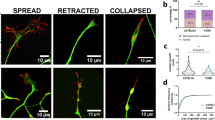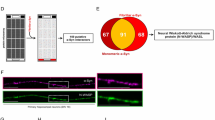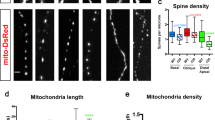Abstract
Inclusions containing actin-depolymerizing factor (ADF) and cofilin, abundant proteins in adult human brain, are prominent in hippocampal and cortical neurites of the post-mortem brains of Alzheimer's patients, especially in neurites contacting amyloid deposits. The origin and role of these inclusions in neurodegeneration are, however, unknown. Here we show that mediators of neurodegeneration induce the rapid formation of transient or persistent rod-like inclusions containing ADF/cofilin and actin in axons and dendrites of cultured hippocampal neurons. Rods form spontaneously within neurons overexpressing active ADF/cofilin, suggesting that the activation (by dephosphorylation) of ADF/cofilin that occurs in response to neurodegenerative stimuli is sufficient to induce rod formation. Persistent rods that span the diameter of the neurite disrupt microtubules and cause degeneration of the distal neurite without killing the neuron. These findings suggest a common pathway that can lead to loss of synapses.
This is a preview of subscription content, access via your institution
Access options
Subscribe to this journal
Receive 12 print issues and online access
$209.00 per year
only $17.42 per issue
Buy this article
- Purchase on Springer Link
- Instant access to full article PDF
Prices may be subject to local taxes which are calculated during checkout






Similar content being viewed by others
References
Richarson, J. S. Cerebral microischemia as a potential precipitant of the neurodegenerative cascade of Alzheimer's disease. Annls N.Y. Acad. Sci. 826, 437–439 (1997).
Lenaz, G. Role of mitochondria in oxidative stress and aging. Biochim. Biophys. Acta 1366, 53–67 ( 1998).
Nicholls, D. G. & Budd, S. L. Mitochondria and neuronal glutamate excitotoxicity. Biochim. Biophys. Acta 1366, 97–112 (1998).
Smith, M. A. et al. Cytochemical demonstration of oxidative damage in Alzheimer disease by immunochemical enhancement of the carbonyl reaction with 2,4-dinitrophenylhydrazine . J. Histochem. Cytochem. 46, 731– 735 (1998).
Schapira, A. H. V. Mitochondrial dysfunction in neurodegenerative disorders. Biochim. Biophys. Acta 1366, 225–233 (1998).
Rapp, P. R. & Gallagher, M. Preserved neuron number in the hippocampus of aged rats with spatial learning deficits. Proc. Natl Acad. Sci. USA 93, 9926–9930 (1996).
Rasmussen, T., Schliemann, T., Sorensen, J. C., Zimmer, J. & West, M. J. Memory impaired aged rats. No loss of principal hippocampal and subicular neurons. Neurobiol. Aging 17, 143–147 ( 1996).
Masliah, E., Terry, R. D., DeTeresa, R. M. & Hansen, L. A. Immunohistochemical quantification of the synapse-related protein synaptophysin in Alzheimer disease. Neurosci. Lett. 103, 234–239 (1989).
Williamson, T. L. & Cleveland, D.W. Slowing of axonal transport is a very early event in the toxicity of ALS-linked SOD1 mutants to motor neurons. Nature Neurosci. 2, 50–56 (1999).
Hall, G. F., Chu, B., Lee, G & Yao, J. Human tau filaments induce microtubule and synapse loss in an in vivo model of neurofibrillary degenerative disease. J. Cell Sci. 113, 1373–1387 (2000).
Kuhn, T. B. et al. Regulating actin filament dynamics in neuronal growth cones by ADF/cofilin and rho family GTPases. J. Neurobiol. 44, 126–144 (2000).
Bamburg, J.R. Proteins of the ADF/cofilin family: essential regulators of actin dynamics . Annu. Rev. Cell Dev. Biol. 15, 185– 230 (1999).
Blanchoin, L. & Pollard, T.D. Mechanism of interaction of Acanthamoeba actophorin (ADF/cofilin) with actin filaments. J. Biol. Chem. 274, 15538–15546 (1999).
McGough, A. & Chiu, W. ADF/Cofilin weakens lateral contacts in the actin filament. J. Mol. Biol. 291, 513–519 (1999).
Carlier, M-F. et al. Actin depolymerizing factor (ADF/cofilin) enhances the rate of filament turnover: implication in actin-based motility. J. Cell Biol. 136, 1307–1322 ( 1997).
Ichetovkin, I., Han, J., Pang, K.M., Knecht, D.A. & Condeelis, J.S. Actin filaments are severed by both native and recombinant Dictyostelium cofilin but to different extents. Cell Motil. Cytoskel. 45, 293–306 ( 2000).
McGough, A., Pope, B., Chiu, W. & Weeds, A. Cofilin changes the twist of F-actin: implications for actin filament dynamics and cellular function. J. Cell Biol. 138, 771– 781 (1997).
Arber, S. et al. Regulation of actin dynamics through phosphorylation of cofilin by LIM-kinase. Nature 393, 805– 809 (1998).
Yang, N. et al. Cofilin phosphorylation by LIM-kinase 1 and its role in Rac-mediated actin reorganization. Nature 393, 809– 812 (1998).
Hall, A. Rho GTPases and the actin cytoskeleton. Science 279 , 509–514 (1998).
Meberg, P.J., Ono, S., Minamide, L.S., Takahashi, M. & Bamburg, J.R. Actin depolymerizing factor and cofilin phosphorylation dynamics: response to signals that regulate neurite extension. Cell Motil. Cytoskel. 39, 172–190 (1998).
Nishida, E., Iida, K., Yonezawa, N., Koyasu, I. & Sakai, H. Cofilin is a component of intranuclear and cytoplasmic rods induced in cultured cells. Proc. Natl Acad. Sci. USA 84, 5262–5266 (1987).
Bershadsky, A.D., Gelfand, V.I., Svitkina, T.M. & Tint, I.S. Destruction of microfilament bundles in mouse embryo fibroblasts treated with inhibitors of energy metabolism. Exp. Cell Res. 127 , 421–429 (1980).
Devineni, N. et al. A quantitative analysis of G-actin binding proteins and the G-actin pool in developing chick brain. Brain Res. 823, 129–140 (1999).
Morgan, T.E., Lockerbie, R.O., Minamide, L.S., Browning, M.D. & Bamburg, J.R. Isolation and characterization of a regulated form of actin depolymerizing factor. J. Cell Biol. 122, 623–633 ( 1993).
Rao, A., Kim, E., Shang, M. & Craig, A.M. Heterogeneity in the molecular composition of excitatory postsynaptic sites during development of hippocampal neurons in culture. J. Neurosci. 18, 1217–1229 (1998).
Brewer, G.J., Torricelli, J.R., Evege, E.K. & Price, P.J. Optimized survival of hippocampal neurons in B27-supplemented Neurobasal, a new serum-free medium combination. J. Neurosci. Res. 35, 567–576 (1993).
Coyle, J.T. & Puttfarcken, P. Oxidative stress, glutamate and neurodegenerative disorders. Science 262, 689–695 (1993).
Bolanos, J.P. et al. Nitric oxide-mediated mitochondrial damage in the brain: mechanisms and implications for neurodegenerative diseases. J. Neurochem. 68, 2227–2240 ( 1997).
Meberg, P.J. & Bamburg, J.R. Increase in neurite outgrowth mediated by overexpression of actin depolymerizing factor. J. Neurosci. 20, 2459–2469 ( 2000).
Grøndahl, T.Ø., Hablitz, J.J. & Langmoen, I.A. Depletion of intracellular Ca2+ stores or lowering extracellular calcium alters intracellular Ca2+ changes during cerebral ischemia. Brain Res. 796, 125–131 (1998).
Berlett, B.B. & Stadtman, E.R. Protein oxidation in aging, disease and oxidative stress. J. Biol. Chem. 272, 20313–20316 (1997).
Ben-Yoseph, O., Boxer, P.A. & Ross, B.D. Assessment of the role of the glutathione and pentose phosphate pathways in the protection of primary cerebrocortical cultures from oxidative stress. J. Neurochem. 66, 2329 –2337 (1996).
Fukui, Y. & Katsumaru, H. Nuclear actin bundles in Amoeba , Dictyostelium and human HeLa cells induced by dimethyl sulfoxide . Exp. Cell Res. 120, 452– 455 (1979).
Kuhn, T.B., Brown, M.D., Wilcox, C.L., Raper, J.A. & Bamburg, J.R. Myelin and collapsin-1 induce motor neuron growth cone collapse through different pathways: inhibition of collapse by opposing mutants of rac1. J. Neurosci. 19, 1965–1975 (1999).
Velasco, M.E., Smith, M.A., Siedlak, S.L., Nunomura, A. & Perry, G. Striation is the characteristic neuritic abnormality in Alzheimer disease. Brain Res. 813, 329–333 (1998).
Hawkins, M., Pope, B., Maciver, S.K. & Weeds, A.G. The interaction of human actin depolymerizing factor with actin is pH regulated. Biochemistry 32, 9985–9993 (1993).
Nishida, E. Opposite effects of cofilin and profilin from porcine brain on rate of exchange of actin-bound adenosine 5′-triphosphate. Biochemistry 24, 1160–1164 (1985).
Chen, H., Bernstein, B.W. & Bamburg, J.R. Regulating actin filament dynamics in vivo. Trends Biochem. Sci. 25, 19–23 (2000).
Kim, S-Y., Grant, P., Lee, J-H., Pant, H.C. & Steinert, P.M. Differential expression of multiple transglutaminases in human brain. Increased expression and cross-linking by transglutaminases 1 and 2 in Alzheimer's disease. J. Biol. Chem. 274, 30715–30721 (1999).
Multhaup, G. et al. Reactive oxygen species and Alzheimer's disease. Biochem. Pharmacol. 54, 533–539 (1997).
Maciver, S.K. & Harrington, C.R. Two actin binding proteins, actin depolymerizing factor and cofilin, are associated with Hirano bodies . Neuroreport 6, 1985–1988 (1995).
Hirano, A. Hirano bodies and related neuronal inclusions. Neuropathol. Appl. Neurobiol. 20, 3–11 ( 1994).
Feldman, M.L. & Peters, A. Intranuclear rods and sheets in rat cochlear nucleus. J. Neurol. 1, 109– 127 (1972).
Hsia, A.Y. et al. Plaque-independent disruption of neuronal circuits in Alzheimer's disease mouse models. Proc. Natl Acad. Sci. USA 96, 3228–3233 (1999).
Behl, C., Davis, J.B., Lesley, R. & Schubart, D. Hydrogen peroxide mediates amyloid β protein toxicity. Cell 77, 817–827 (1994).
Bartlett, W.P. & Banker, G.A. An electron microscopic study of the development of axons and dendrites by hippocampal neurons in culture. I. Cells which develop without intercellular contacts. J. Neurosci. 4, 1944–1953 (1984).
Mattson, M.P. & Kater, S.B. Isolated hippocampal neurons in cryopreserved long-term cultures: development of neuroarchitecture and sensitivity to NMDA. Int. J. Dev. Neurosci. 6, 439– 452 (1988).
Abe, H., Endo, T., Yamamoto, K. & Obinata, T. Sequence of cDNAs encoding actin depolymerizing factor and cofilin of embryonic chicken skeletal muscle: two functionally distinct actin-regulatory proteins exhibit high structural homology. Biochemistry 29, 7420– 7425 (1990).
Rudelli, R.D., Ambler, M.W. & Wisniewski, H.M. Morphology and distribution of Alzheimer neuritic (senile) and amyloid plaques in striatum and diencephalon. Acta Neuropathol. 64, 273–281 (1984).
Acknowledgements
We thank the National Institutes of General Medical Sciences, NIH (GM35126 and GM54004), the National Science Foundation (DBI-9531511), and the American Paralysis Association (BB2-9601) for supporting this work. We thank B. Bernstein, B. Molitoris and D. Cleveland for valuable discussions, J. Sneider for technical assistance, and W. M. Frederick for assistance with computer graphics. We are greatly indebted to E. Masliah and M. Mallory for the human brain sections and technical assistance on staining. Part of this work was done during a sabbatical leave (J.R.B.) from Colorado State University. We thank D. Cleveland for his generous hospitality at the Ludwig Institute for Cancer Research, University of California San Diego.
Author information
Authors and Affiliations
Corresponding author
Rights and permissions
About this article
Cite this article
Minamide, L., Striegl, A., Boyle, J. et al. Neurodegenerative stimuli induce persistent ADF/cofilin–actin rods that disrupt distal neurite function. Nat Cell Biol 2, 628–636 (2000). https://doi.org/10.1038/35023579
Received:
Revised:
Accepted:
Published:
Issue Date:
DOI: https://doi.org/10.1038/35023579
This article is cited by
-
Molecular signatures of inherited and acquired sporadic late onset nemaline myopathies
Acta Neuropathologica Communications (2023)
-
Neuroligin 2 governs synaptic morphology and function through RACK1-cofilin signaling in Drosophila
Communications Biology (2023)
-
Resveratrol Preconditioning Protects Against Ischemia-Induced Synaptic Dysfunction and Cofilin Hyperactivation in the Mouse Hippocampal Slice
Neurotherapeutics (2023)
-
Cofilactin filaments regulate filopodial structure and dynamics in neuronal growth cones
Nature Communications (2022)
-
An Update on the Critical Role of α-Synuclein in Parkinson’s Disease and Other Synucleinopathies: from Tissue to Cellular and Molecular Levels
Molecular Neurobiology (2022)



